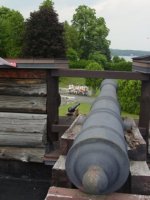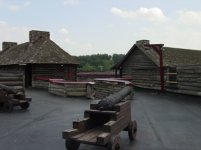You are using an out of date browser. It may not display this or other websites correctly.
You should upgrade or use an alternative browser.
You should upgrade or use an alternative browser.
Ssorc - cannons (1 Viewer)
- Thread starter Fraxinus
- Start date
ssorc1
Private 2
- Joined
- Nov 13, 2008
- Messages
- 143
Thanks for all of your interest. I hope we haven't misunderstood each other in the scale that I am planning on building this in? As much as I would love to build this fort in a large scale - I am only building this in 1/30 scale to match up with my FIW figures. The fort I sold to Jenkins was a 28mm scale for his wargames. I stopped with the smaller scale and then shifted to Jenkins FIW figures. I still want the FWH so the plans and the method of building has been to scale it to those figures. I am very interested in constructing it - as much as possible - the way it was engineered - but in a miniature version. I've been pulling a lot of research so that I don't just build something that is a facsimile but more of a true museum quality piece. Hope that helps to clear up any possible misunderstanding. You have been an awesome source of info, so again much appreciated. Cheers, ssorc1.
whdamon
Corporal
- Joined
- Sep 22, 2009
- Messages
- 442
Here are some photos I took of cannons at FT WH this past summer........not sure if this helps, but might give you some ideas. Interested in what you are building so keep us posted. I have a few more photos of the Fort if you need them
Walt
Walt
Attachments
ssorc1
Private 2
- Joined
- Nov 13, 2008
- Messages
- 143
These pictures are great, thanks. I've managed to download quite a few off over time from various pic sites, history sites etc. One day I'll actually have to get there myself and take my own pictures. I'll definitely be keeping you guys that have helped in this in the loop on my success. I've been modeling for a number of years so I'm fairly confident in the final product, the question will be time. I'd love to have it done before the year is out. I'm keeping a record of my progress so hopefully I can help someone else attempt it, or if I do it extremely well and it isn't too time-consuming I may offer them up for sale at some point. Thanks again for all your help. The pics are excellent. Cheers, ssorc1
ssorc1
Private 2
- Joined
- Nov 13, 2008
- Messages
- 143
Hey Mark,
Thanks for the well wishing. I'll definitely let you know what the final result is like. It seems to be going quite well, once I simply got the plans down. It's all about scale. Now I'm seeing which materials and finishings work the best before I settle in and do the actual build out. I have a way now to take any section of the fort that I have reference for and thanks to everyone, and the internet I've pulled almost all the various angles, buildings etc. Building this sucker up full would take quite a bit of space but be amazing to see - the bastion is roughly a 24" x 36" space - not big by any normal means but times that by 4 and include all the curtain walls etc. I can do this section by section so depending on if someone like yourself wanted a bastion, gate and surrounding curtain wall etc. I could probably do that. Anyway, I'll be sure to show you first when the results are in. I don't foresee Jenkins doing much around FWH or Ticonderoga so I'll have to adapt whatever figures I can for this diorama. Thank God that AIP made the early Jenkins/Frontline stuff in plastic. Some nice conversion potential there. Ticonderoga is definitely next. Probably the French defensive works. Cheers Mark.
Thanks for the well wishing. I'll definitely let you know what the final result is like. It seems to be going quite well, once I simply got the plans down. It's all about scale. Now I'm seeing which materials and finishings work the best before I settle in and do the actual build out. I have a way now to take any section of the fort that I have reference for and thanks to everyone, and the internet I've pulled almost all the various angles, buildings etc. Building this sucker up full would take quite a bit of space but be amazing to see - the bastion is roughly a 24" x 36" space - not big by any normal means but times that by 4 and include all the curtain walls etc. I can do this section by section so depending on if someone like yourself wanted a bastion, gate and surrounding curtain wall etc. I could probably do that. Anyway, I'll be sure to show you first when the results are in. I don't foresee Jenkins doing much around FWH or Ticonderoga so I'll have to adapt whatever figures I can for this diorama. Thank God that AIP made the early Jenkins/Frontline stuff in plastic. Some nice conversion potential there. Ticonderoga is definitely next. Probably the French defensive works. Cheers Mark.
SSORCI......Good luck on your project sounds very intersting and lots of work. I have done 2 forts FORT GEORGE and FORT KINGSTON but were eventually destroyed by the enemy my 2 boys when they were younger....I am thinking of starting another fort.
mikemiller1955
Lieutenant General
- Joined
- Aug 3, 2008
- Messages
- 17,490
SSORCI......Good luck on your project sounds very intersting and lots of work. I have done 2 forts FORT GEORGE and FORT KINGSTON but were eventually destroyed by the enemy my 2 boys when they were younger....I am thinking of starting another fort.
Hehehehe...the enemy...wives, children and sometimes pets.
Trying to attach an excel file. Bah, didn't work.
Standard Protocols: Bastion tracing was done via intersecting lines with limited need to determine angles. You only had to be able to determine a 90 degree angle in the field. But when you were done and if you measured, the textbook results were -----
Curtain to Flank was a 75 degree angle or 105 degrees ---- 15 degress off of 90 degrees.
Flank to Face was 60 Degrees.
Face to Face was 60 Degrees.
The key point is this is very easy on the miter saws!!!!
Face Length is 2/7 of the distance of bastion point to bastion point on that side of the fort. This 2/7 value was used in the field.
Other values when you were done with the field tracing, if you measured them ---
Curtain wall is .40 of the distance of bastion point to bastion point.
Flank was about .11 of the distance of bastion point to bastion point or just under 11%.
Field conditions would of course modify these results, the values I have given are only textbook for perfectly flat and level ground.
See Tracing Bastions on the Civil War Fortification Page.
Standard Protocols: Bastion tracing was done via intersecting lines with limited need to determine angles. You only had to be able to determine a 90 degree angle in the field. But when you were done and if you measured, the textbook results were -----
Curtain to Flank was a 75 degree angle or 105 degrees ---- 15 degress off of 90 degrees.
Flank to Face was 60 Degrees.
Face to Face was 60 Degrees.
The key point is this is very easy on the miter saws!!!!
Face Length is 2/7 of the distance of bastion point to bastion point on that side of the fort. This 2/7 value was used in the field.
Other values when you were done with the field tracing, if you measured them ---
Curtain wall is .40 of the distance of bastion point to bastion point.
Flank was about .11 of the distance of bastion point to bastion point or just under 11%.
Field conditions would of course modify these results, the values I have given are only textbook for perfectly flat and level ground.
See Tracing Bastions on the Civil War Fortification Page.
Last edited:
My guess is the SW and SE bastions of FWH are probably close to the ideal textbook. The NW bastion is a "fatty", whereas the NE is Skinny.
The skinny NE bastion would be fine as it wasn't expected to be attacked by cannon. If you knew where an attck would be likely, you can beef up the dimensions of a bastion to make more room for cannons and make the internal area of the bastion more manageble and not a cramped (recoil) ......
Bah, my excel table blew up again !!! so summarizing ....
For a fort wall that is 300 feet from bastion tip to bastion tip, similar to FWH, the textbook:
Bastion Tip to Bastion Tip is 300 feet = 125 inches at 30 Scale.
Face is 85.71 Feet = 34.29 inches at 30 scale.
Flank is 32.5 - 33 Feet = 13 to 13.2 inches at 30 scale, 2 diffeent methods of calculation.
Curtain is 120 feet = 48 inches at 30 scale.
Again, the key point is very friendly on the miter saws if you use the "textbook" method (see below).
The skinny NE bastion would be fine as it wasn't expected to be attacked by cannon. If you knew where an attck would be likely, you can beef up the dimensions of a bastion to make more room for cannons and make the internal area of the bastion more manageble and not a cramped (recoil) ......
Bah, my excel table blew up again !!! so summarizing ....
For a fort wall that is 300 feet from bastion tip to bastion tip, similar to FWH, the textbook:
Bastion Tip to Bastion Tip is 300 feet = 125 inches at 30 Scale.
Face is 85.71 Feet = 34.29 inches at 30 scale.
Flank is 32.5 - 33 Feet = 13 to 13.2 inches at 30 scale, 2 diffeent methods of calculation.
Curtain is 120 feet = 48 inches at 30 scale.
Again, the key point is very friendly on the miter saws if you use the "textbook" method (see below).
ssorc1
Private 2
- Joined
- Nov 13, 2008
- Messages
- 143
SSORCI......Good luck on your project sounds very intersting and lots of work. I have done 2 forts FORT GEORGE and FORT KINGSTON but were eventually destroyed by the enemy my 2 boys when they were younger....I am thinking of starting another fort.
LOL. I know how you feel. Every diorama I ever built became the playmat for my son and his friends. The enemy is right. On a positive note I think that for all the destruction that happened I can say that in that time, and hopefully even to today, the boys got a taste for the toy soldier hobby and for history
in general. Hopefully as well they will pass it on. This latest fort however is strictly hands off. Until I get grandkids I suppose. We'll see. Cheers, ssorc1
Users who are viewing this thread
Total: 2 (members: 0, guests: 2)




